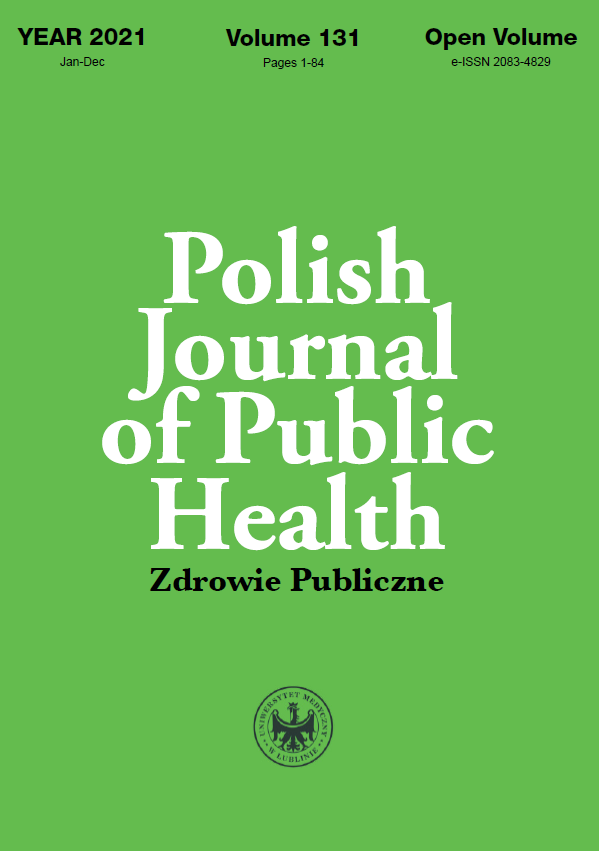The knowledge of young women about cervical cancer
DOI:
https://doi.org/10.2478/pjph-2021-0009Keywords:
prevention, health education, cancer, cervical cancerAbstract
Introduction. Women in Poland suffer from and die of cervical cancer more often than women from other European countries. The reason for this phenomenon is the fact that women in Poland are reluctant to perform Pap smear tests. Reluctance to undergo a Pap smear is due to low awareness of its course. Numerous studies show that women do not know much about the course of illness, risk factors and prevention of cervical cancer. In its prevention, health behaviors are important from the moment of sexual initiation, so it is important that young women have sufficient knowledge about it.
Aim. Determining the state of knowledge of the respondents, comparing social awareness to previous research and proposing new preventive solutions.
Material and methods. An anonymous questionnaire survey was conducted in electronic form among women aged 16-25 from all over Poland. The study was conducted using a proprietary questionnaire (Google form) completed online. The questionnaire contained closed questions verifying the knowledge of the topic under study and personal information. The following computer programs were used for statistical analysis of data: Statistica and Microsoft Excel.
Results. Almost half of the surveyed women believes that the use of oral hormonal contraception does not increase the risk of developing cervical cancer. One in ten women does not know about the existence of an HPV vaccine. Nearly one third of the respondents do not see a gynecologist at all. Nearly two-thirds of women do not perform a Pap smear.
Conclusions. The surveyed women have some knowledge concerning cervical prophylaxis, but they rarely use it in practice. However, the knowledge of women about the symptoms and risk factors of cervical cancer is small. Too few women know about the existence of a cervical cancer prevention program in Poland.
References
1. World Health Organization; 2021. [https://www.who.int/health-topics/ cervical-cancer#tab=tab_1]
2. Krajowy Rejestr Nowotworów; 2021. [http://onkologia.org.pl/ raporty/#tabela_rok]
3. European Caancer Information System; 2021. [https://ecis.jrc.ec.europa. eu/]
4. Pasławska A, Mrożek-Budzyn D, Majewska R. Wiedza młodych kobiet na temat znaczenia badań cytologicznych w profilaktyce raka szyjki macicy. Probl Hig Epidemiol. 2014;95(1):170-4.
5. Baran W, Kornacka K, Szela S. Ocena wiedzy kobiet z Podkarpacia na temat profilaktyki raka szyjki macicy Instytut Położnictwa i Ratownictwa Medycznego Uniwersytetu Rzeszowskiego. Prz Med Uniw Rzesz Inst Leków. 2013;3:311-8.
6. Ono A, Koshiyama M, Nakagawa M, et al. The preventive effect of dietary antioxidants on cervical cancer development. Medicina (Kaunas). 2020;56(11):604
7. P Appleby, V Beral, A Berrington de González, et al. Carcinoma of the cervix and tobacco smoking: collaborative reanalysis of individual data on 13,541 women with carcinoma of the cervix and 23,017 women without carcinoma of the cervix from 23 epidemiological studies. IJC. 2006;118(6):1481-95.
8. Asthana S, Busa V, Labani S. Oral contraceptives use and risk of cervical cancer-A systematic review & meta-analysis. Eur J Obstet Gynecol Re-prod Biol. 2020;247:163-75.
9. Yang M, Li L, Jiang C, et al. Co-infection with trichomonas vaginalis increases the risk of cervical intraepithelial neoplasia grade 2-3 among HPV16 positive female: a large population-based study. BMC Infect Dis. 2020;20:642.
10. Łaniewski P, Esra Ilhan Z, Herbst-Kralovetz M. The microbiome and gynaecological cancer development, prevention and therapy. Nat Rev Urol. 2020;17:232-50.
11. Jach R, Radoń-Pokracka M, Kolawa W, et al. Rak szyjki macicy w przebiegu ciąży. Trudności diagnostyczne i powikłania. Curr Gynecol Oncol. 2010;8(2):112-22.
12. Kalinowski P, Wala S. Wiedza o czynnikach ryzyka i metodach profilaktyki raka szyjki macicy wśród studentek szkół wyższych w Lublinie. Probl Hig Epidemiol. 2014;95(2):460-4.
13. Sawaryn D, Wróbel A. Poziom wiedzy młodych dziewcząt na temat raka szyjki macicy. Med Rodz. 2011;2:35-42.
14. Nowicki A, Farbicka P, Anczura K. Wiedza uczennic technikum i absolwentek studiów wyższych z zakresu profilaktyki i leczenia raka szyjki macicy. Pielęg Pol. 2017;64(2):246-53.
Downloads
Published
Issue
Section
License
Copyright (c) 2021 Polish Journal of Public Health

This work is licensed under a Creative Commons Attribution-NonCommercial-NoDerivatives 3.0 Unported License.


